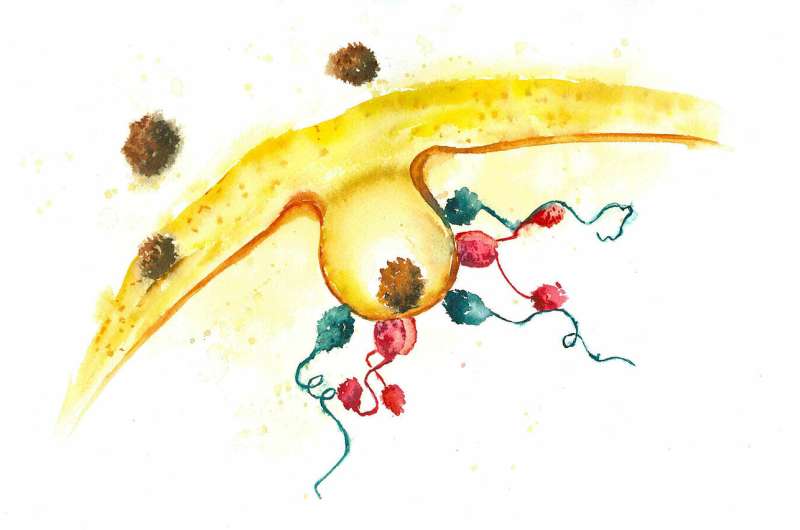This article has been reviewed according to Science X's editorial process and policies. Editors have highlighted the following attributes while ensuring the content's credibility:
fact-checked
peer-reviewed publication
trusted source
proofread
New interaction network in endocytosis process discovered

AP180 is a protein involved in endocytosis and in signal transmission between nerve cells. This protein, which largely lacks a three-dimensional structure, has never been fully studied.
Using solution NMR spectroscopy, scientists from the Leibniz-Forschungsinstitut für Molekulare Pharmakologie (FMP) were able to examine each of its 600 unstructured amino acids individually and by doing so discovered a new interaction network. The paper was recently published in Nature Communications.
To allow substances such as neurotransmitters, nutrients, and even viruses to enter our cells, they are enclosed in vesicles at the cell membrane and transported into the cell interior. This transport process is called endocytosis. In clathrin-mediated endocytosis, protein complexes of the same name form a stabilizing scaffold around the vesicles to ensure the cargo safely reaches its destination.
Clathrin is recruited by various proteins, one of which is AP180. It is only active in neurons, or nerve cells, and is involved in recycling synaptic vesicles. This is a crucial task because synaptic vesicles are essential for signal transmission between nerve cells. Recently, AP180 has been linked to neurodegenerative diseases.
Intrinsically disordered proteins are difficult to study
However, how exactly AP180 interacts with other proteins is still not well understood. The problem is that 600 amino acids of AP180 are intrinsically disordered, meaning they have no stable three-dimensional structure, making them extremely difficult to analyze. Additionally, the disordered domain of AP180 is particularly long. So far, only individual sections have been analyzed, but never the entire disordered domain in the context of clathrin-mediated endocytosis.
Dr. Sigrid Milles' team from the Leibniz-Forschungsinstitut für Molekulare Pharmakologie (FMP) in Berlin has now shed light on this issue. Using solution NMR spectroscopy, the researchers were able to examine the entire disordered domain in full length at the molecular level for the first time and discover its true function.
AP180 interacts not only with the structural protein clathrin but also with the adaptor protein complex AP2, at many small interaction sites previously associated only with clathrin. The researchers also identified a much larger interaction site with an interaction strength several orders of magnitude greater than previously known sites.
Interaction between AP180 and AP2 was completely unknown
"We looked at amino acid by amino acid and discovered a previously unknown interaction network," explains Samuel Naudi-Fabra, the study's first author. "We were able to investigate this network at the molecular level and now understand which specific amino acids in AP180 and AP2 are involved in the interaction, the strength of the interaction, and the dynamics of the process."
The researchers suspect that the newly discovered interaction occurs very early in the process of clathrin-mediated endocytosis. Over time, more and more endocytosis proteins come together until a vesicle eventually buds off from the membrane to transport cargo, such as a transmembrane receptor, into the cell interior.
Therefore, the interaction between AP180 and AP2 is an important facilitator of the transport process, but it is evidently not the only one. "Fundamentally, our discovery shows that in addition to the known interactions in the early stages of clathrin-mediated endocytosis, there seem to be many other interactions," says group leader Milles.
"We were able to show that it is possible to examine these long disordered domains of endocytosis proteins at the molecular level and finally gain a deeper understanding of the important process of endocytosis."
The method was crucial for the work: only NMR spectroscopy allows such detailed and high-resolution investigations. In this field, the FMP with its NMR facility is one of the leading research institutions in Germany.
Using NMR and in combination with other innovative methods, such as single-molecule fluorescence spectroscopy, Milles and her team aim to reveal further details about clathrin-mediated endocytosis in the future. The current discovery is just one piece of a complex biological process that may later be significant for understanding diseases such as neurodegenerative disorders.
More information: Samuel Naudi-Fabra et al, An extended interaction site determines binding between AP180 and AP2 in clathrin mediated endocytosis, Nature Communications (2024). DOI: 10.1038/s41467-024-50212-4
Journal information: Nature Communications
Provided by Forschungsverbund Berlin e.V. (FVB)





















